Introduction The month experienced a drop in precipitation and heightened wildebeest migration activity
Introduction
The month experienced a drop in precipitation and heightened wildebeest migration activity. Poaching incidences still occurred especially among the elephants though with reduced level.Atleast one female elephant nursing hardly two year old calf succumbed to injuries as a result of spearing with suspected poison laced spear. Poisoned spears and arrows are now becoming silent killer weapons as opposed to firearms traditionally known to be weapons associated with elephant poachers.
Below are activities undertaken by the unit during the month.
Case#1: Post mortem of an adult female elephant at Olkinyei conservancy
Date: 12th August 2013
Species: Elephant
Sex: Female
Age: Adult (about 30-35yrs)
Location: Olkinyei
GPS coordinates 36M0770598, UTM9846500
History
Management of Olkinyei conservancy spotted this elephant on the morning of 12th August2013 with what appeared like a small wound discharging straw colored fluid on the lateral side of its right thigh. The elephant was also reported to be disinclined to move but restless and looked like in pain.
The management duly informed the mobile veterinary team on the ground which responded immediately. However, the elephant died before being attended to.
General examination:
- The examination of the carcass revealed an elephant that was in good body condition with an average score of 4 in a scale of 1to5 where 1 is poor and 5 is perfect.
- The elephant appeared to have been nursing a young one as evidenced by engorged mammary glands with indications of recent use (fresh milk sticking to the walls of teat nipples and could as well be expressed easily.)
- The elephant had only one tusk (left) which was removed and handed over to KWS security personnel for safe keeping. The right tusk was congenitally absent, thought to be a genetic disorder.
- There was a wound on the lateral side of her thigh with straw colored discharge.
Significant findings
Of significance was the wound on her right thigh which measured about five inches wide and ten inches deep. The wound was penetrative and had sharp edges suggestive of sharp object inflicted. The muscles around the thigh were fast becoming necrotic with straw colored discharge. All other organs inspected were grossly normal.
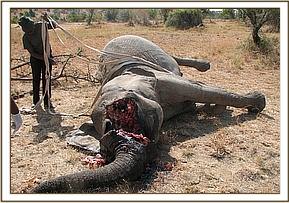

Conclusion
- Based on history and post mortem examination conducted, this elephant died of suspected spearing with poisoned laced spear. Quick tissue necrosis was as a result of high concentration of poison at the point of injury.
- These findings highly suggest human involvement in the death of this elephant.
Case#2: Treatment of an adult elephant bull at Olarro conservancy
Date: 12th August2013
History
This elephant of about 40years was spotted limping and unable to keep pace with other elephants by the Olarro conservancy patrol team. The elephant soon isolated itself from the rest of the elephants.
They immediately informed the mobile veterinary unit who responded and confirmed the elephant had an injury requiring quick attention. The elephant could not bear weight on its left front limb
Immobilization
This was achieved by use of 16mgs etorphine delivered remotely through Dan inject darting system. Because of the terrain of the area, darting was done by foot. The drug took effect after eight minutes with the elephant assuming left lateral recumbency.
Examination and treatment;
The elephant had to be turned over in order to assess the injured limb. This was achieved by use of ropes, vehicle to pull and people to push him over.
On examination, there was an infected wound suspected to have been caused by spearing on the left elbow joint. The wound had thick pus which was effectively drained.
The wound was then debrided with help of hydrogen peroxide. It was then washed with plenty of water before hydrogen peroxide being applied. Oxytetracycline spray was then used on the wound before applying green clay to absorb toxins and hasten healing.
The elephant was given 30,000mgs of oxytetracycline antibiotic intramuscularly.
Revival
This was achieved by giving 48mgs diprenorphine intravenously through the ear vein and the elephant woke up and walked away after three minutes
Prognosis
Good.

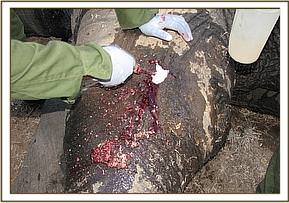
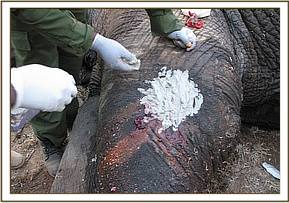

Case#3: Treatment of manged cheetahs.
Date: 16th August 2013
A female cheetah christened Narasha with her two cubs; a male and a female are an attraction for tourists at Olkiombo area close to Olare Orok conservancy. Mara cheetah project team have been following this family and reported that they were seeing increased severity of mange infestation of both the mother and the male cub.
Examination and treatment:
The family had killed an impala the previous day and was relaxing underneath a small shrub. They were unperturbed by our presence and on closer examination with the aid of binoculars; we found out that the mother and male cub had mange which deserved intervention. The distribution of the infestation was severe on the front limbs and mild on the face and ears. The female cub appeared clear of the infestation.
We thought it wise not to immobilize the cheetahs but to treat by delivering the ant parasitic drug remotely by darting. The degree of infestation according to our assessment did not require aggressive approach hence felt no need to immobilize.
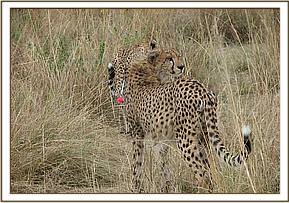

A dose of 15mgs ivermectin was prepared for reach of the two infested cheetahs. This was then subsequently delivered through a 1.5ml Daninject dart with a plain 30mm length needle. This effectively delivered the drug subcutaneously/intramuscularly.The remaining female cub will be treated when the two receive a second treatment in three weeks time. The darts fell off a few minutes after darting. After the treatment, the cheetahs did not exhibit any strange behavior and were lucky to kill a young wildebeest the next day.
Case #4 – Rescue of an abandoned elephant calf.
Date: 17th August 2013
Location: Serena, Mara Conservancy.
GPS coordinates S01.33254° E034.92590°
This male elephant calf of about two years had been reported for days prior by Mara conservancy management as having been spotted lonely and lethargic.
The mobile veterinary team on the ground advised on close monitoring to see whether any of the resident elephant families could adopt him. He was new in the area and appears like he lost his mother or he could have strayed away from the other family members. He was still at suckling age. This elephant calf refused to join any of the families despite spirited attempts to push him into any of the groups. He even moved away as soon as a group approached him. He kept isolating himself and became weary by day. Its body condition was deteriorating at an alarming rate and at a point could not feed. After consultation with relevant stakeholders a decision was made to rescue him and take him to the Sheldrick orphanage in Nairobi for specialized care and attention. This would also give an opportunity to bond with other orphans from other areas of the country.

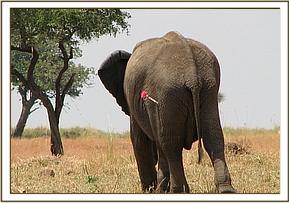


Capture, assessment and management
This was achieved by use of 50mg azaperone delivered through Dan inject darting system. The calf was calm in 10mins after which he was manually restrained. On assessment the elephant appeared severely dehydrated, anemic and displayed pot belly syndrome. He was also weak and emaciated with signs of gross malnutrition. Other vital parameters were within range. He was then loaded into padded vehicle, given antibiotics parenterally. He was given ringers lactate drip intravenously to rehydrate him and later on replaced this with 10% dextrose to give him energy on transit. Upon release at the orphanage he was assisted to rise and given catabolics for muscle activity. He was able to drink water and was provided with lush fodder.
Case #5: Treatment of an injured lion cub
Date: 26th August 2013
History
Warden Masai mara game reserve, Talek gate reported having spotted a female lion cub about nine months old limping and unable to keep pace with other pride members. This was near fig tree camp. He sought the assistance of the ground veterinary team to capture, assess and treat the cub.
Capture and assessment
This was achieved by use of 2mg medetomidine and 130mg Ketamine delivered through 3ml Dan inject dart. Full anaesthesia took effect after eight minutes. The eyes were covered with towel and opticlox eye ointment was applied to prevent dessication. It was in perfect body condition .On assessment it was found out that the cub had dislocated its left shoulder joint. No fracture was evident. It appeared like the mother and other pride members were taking care of her.
Treatment
20mg of Dexamethasone sodium anti-inflammatory was administered intramuscularly. In addition 10mg ivermectin was given subcutaneously to take care of internal and external parasites.
Revival
This was achieved by giving 6mg atipamizole HCL given intramuscularly after 1hr to reverse medetomidine when Ketamine effects had worn off.
Prognosis
Guarded to good.


Case #6: Removal of a spear lodged in the neck of a male Masai giraffe.
Date: 28th august 2013.
Location: Olkurruk Area, Mara Conservancy
History
Warden Oloololo gate reported that his patrol team had come across a male Masai giraffe in Olkurruk area with a spear lodged on the right side of its neck. The giraffe is said to have possibly been speared a day earlier. They kept monitoring its movement while waiting for our help. The terrain was bad and the area was covered by closely knit thickets that hindered capture. After struggling to dart it for 1hr the spear fell off most probably due to hastened activity. On examination through binoculars the resultant wound was fresh and small and the giraffe was in good spirits. We agreed not to disturb it any more but the patrol team to keep on monitoring and update us on the progress and if need be can be captured at a later date.
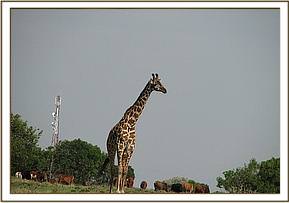
Conclusion.
The mara mobile veterinary unit would wish to thank the David Sheldrick Wildlife Trust and the Kenya Wildlife Service for their continued support towards the important wildlife conservation activities in the Masai mara ecosystem.
Report by: Dr Campaign Limo